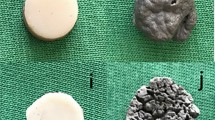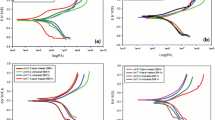Abstract
The aim of this study was to evaluate the elemental release from a Ni–Cr dental casting alloy subjected to 10% hydrogen peroxide (HP) or 10% carbamide peroxide (CP) solutions and to determine the composition of surface oxide layer formed on alloy samples. Cylinder-shaped 15 specimens were cast from a Ni–Cr alloy and divided into three groups (n = 5). Samples were exposed either to phosphate-buffer solution, HP, or CP for 30 days, and total mass and individual elements (Ni, Cr, Mo) released into solutions were measured by means of atomic absorption spectrometry. Before and after elemental release measurements, a scanning electron microscope (SEM) accompanied by energy dispersive spectroscopy (EDS) (SEM/EDS) was used to analyze the surface morphology, and surface characterization of passive film formed on alloy samples was also performed by using X-ray photoelectron spectroscopy (XPS). The presence of bleaching agents induced the mass released compared to control group (4.9 μg/cm2); this effect was recorded in both HP (171.2 μg/cm2) and CP (59.7 μg/cm2). XPS data showed that Cr and Ni levels in oxide layers formed on HP group were higher, Mo level was lower than those of CP group.



Similar content being viewed by others
References
Leinfelder KF (1997) An evaluation of casting alloys used for restorative procedures. J Am Dent Assoc 128:37–45
Nelson SK, Wataha JC, Lockwood PE (1999) Accelerated toxicity testing of casting alloys and reduction of intraoral release of elements. J Prosthet Dent 81:715–720
Al-Hity RR, Kappert HF, Viennot S, Dalard F, Grosgogeat B (2007) Corrosion resistance measurements of dental alloys, are they correlated? Dent Mater 23:679–623
Schmalz G, Garhammer P (2002) Biological interactions of dental cast alloys with oral tissues. Dent Mater 18:396–406
Gil FJ, Sánchez LA, Espías A, Planell JA (1999) In vitro corrosion behaviour and metallic ion release of different prosthodontic alloys. Int Dent J 49:361–367
Wataha JC (2000) Biocompatibility of dental casting alloys: a review. J Prosthet Dent 83:223–234
Al-Hiyasat AS, Darmani H (2005) The effects of recasting on the cytotoxicity of base metal alloys. J Prosthet Dent 93:158–163
Geurtsen W (2002) Biocompatibility of dental casting alloys. Crit Rev Oral Biol Med 13:71–84
Wataha JC (2002) Alloys for prosthodontic restorations. J Prosthet Dent 87:351–363
Nascimento ML, Mueller W-D, Carvalho AC, Tomás H (2007) Electrochemical characterization of cobalt-based alloys using the mini-cell system. Dent Mater 23:369–373
Huang H-H (2003) Surface characterization of passive film on NiCr-based dental casting alloys. Biomaterials 24:1575–1582
Roach MD, Wolan JT, Parsell DE, Bumgardner JD (2000) Use of X-ray photoelectron spectroscopy and cyclic polarization to evaluate the corrosion behavior of six nickel–chromium alloys before and after porcelain-fused-to-metal firing. J Prosthet Dent 84:623–634
Huang H-H (2002) Effect of chemical composition on the corrosion behavior of Ni–Cr–Mo dental casting alloys. J Biomed Mater Res 60:458–465
Rotstein I, Avron Y, Shemesh H, Dogan H, Mor C, Steinberg D (2004) Factors affecting mercury release from dental amalgam exposed to carbamide peroxide bleaching agent. Am J Dent 17:347–350
Attin T, Hannig C, Wiegand A, Attin R (2006) Effect of bleaching on restorative materials and restorations—a systematic review. Dent Mater 20:852–861
Nour El002DDin AK, Miller BH, Griggs JA, Wakefield C (2006) Immediate bonding to bleached enamel. Oper Dent 31:106–114
Steinberg D, Blank O, Rotstein I (2003) Influence of dental biofilm on release of mercury from amalgam exposed to carbamide peroxide. J Biomed Mater Res Part B: Appl Biomater 67B:627–631
Canay Ş, Çehreli MC, Bilgiç S (2002) In vitro evaluation of the effect of a current bleaching agent on the electrochemical corrosion of dental alloys. J Oral Rehabil 29:1014–1019
Ameer MA, Khamis E, Al-Motlaq M (2004) Electrochemical behavior of non-precious dental alloys in bleaching agents. Electrochim Acta 50:141–148
Messer RLW, Lucas LC (2000) Cytotoxicity of nickel–chromium alloys: bulk alloys compared to multiple ion salt solutions. Dent Mater 16:207–212
Geis-Gerstorfer J, Sauer K-H, Pässler K (1991) Ion release from Ni–Cr–Mo and Co–Cr–Mo casting alloys. Int J Prosthodont 4:152–158
Johansson BI, Lucas LC, Lemons JE (1989) Corrosion of copper, nickel, and gold dental casting alloys: an in vitro and in vivo study. J Biomed Mater Res: Appl Biomater 23(A3):349–361
Wataha JC, Lockwood PE, Mettenburg D, Bouillaguet S (2003) Toothbrushing causes elemental release from dental casting alloys over extended intervals. J Biomed Mater Res Part B: Appl Biomater 65B:180–185
Wataha JC, Lockwood PE, Khajotia SS, Turner R (1998) Effect of pH on element release from dental casting alloys. J Prosthet Dent 80:691–698
Wataha JC, Lockwood PE (1998) Release of elements from dental casting alloys into cell-culture medium over 10 months. Dent Mater 14:158–163
ISO Standards (1997) ISO 10993-5. Biological evaluation of medical devices: part 5: tests for cytotoxicity: in vitro methods
Wylie CM, Shelton RM, Fleming GJP, Davenport AJ (2007) Corrosion of nickel-based casting alloys. Dent Mater 23:714–723
Rotstein I, Mor C, Arwaz JR (1997) Changes in surface levels of mercury, silver, tin, and copper of dental amalgam treated with carbamide peroxide and hydrogen peroxide in vitro. Oral Surg Oral Med Oral Pathol Oral Radiol Endod 83:506–509
Wataha JC (2001) Principles of biocompatibility for dental practitioners. J Prosthet Dent 86:203–209
Cavalli V, Reis AF, Giannini M, Ambrosano GMB (2001) The effect of elapsed time following bleaching on enamel bond strength of resin composite. Oper Dent 26:597–602
Gettleman L, Cocks FH, Darmiento LA, Levine PA, Wright S, Nathanson D (1980) Measurement of in vivo corrosion rates in baboons and correlation with in vitro tests. J Dent Res 59:689–707
Petoumenou E, Arndt M, Keilig L, Reimann S, Hoederath H, Eliades T, Jäger A, Bourauel C (2009) Nickel concentration in the saliva of patients with nickel–titanium orthodontic appliances. Am J Orthod Dentofac Orthop 135:59–65
Wataha JC, Sun ZL, Hanks CT, Fang DN (1997) Effects of Ni ions on expression of intercellular adhesion molecule 1 by endothelial cells. J Biomed Mater Res 36:145–151
Wataha JC, Lockwood PE, Marek M, Ghazi M (1999) Ability of Ni-containing biomedical alloys to activate monocytes and endothelial cells in vitro. J Biomed Mater Res 45:251–257
Acknowledgements
This investigation was supported by Ankara University Research Foundation Grant No: 2005.08.02.065.
XPS measurements were done by METU Central Laboratory and Development.
Authors are grateful to Dilşen TAMAM for statistical analysis and Ayberk YAĞIZ for artworks.
Conflict of interest
The authors declare that they have no conflict of interest.
Author information
Authors and Affiliations
Corresponding author
Rights and permissions
About this article
Cite this article
Tamam, E., Aydın, A.K. Surface characterization of passive film and elemental release analysis of a Ni–Cr alloy during bleaching, part I: effects of different bleaching agents. Clin Oral Invest 15, 375–382 (2011). https://doi.org/10.1007/s00784-010-0391-0
Received:
Accepted:
Published:
Issue Date:
DOI: https://doi.org/10.1007/s00784-010-0391-0




